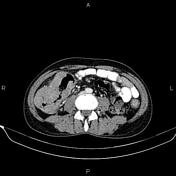Large bowel lymphoma
Updates to Article Attributes
Large bowel (colorectal) lymphoma is a very rare tumour, accounting for <0.5% of primary colorectal malignancies, ~1.5% of all lymphomas, and ~15% of gastrointestinal lymphomas. Large bowel lymphoma differs from gastric and small bowel lymphoma in clinical presentation, management, and prognosis.
Epidemiology
Most commonly occurs in patients in their 40s to 60s, with increasing incidence with age. There is a slight male predominance (M:F = 1.5:1) 2.
Clinical presentation
As with other colorectal tumours, primary symptoms are weight loss, pain and, less commonly, per rectal bleeding 2. Large bowel obstruction and perforation are rare.
Pathology
Diffuse large B-cell lymphoma is the most common subtype (~65%) of large bowel lymphoma. Less common subtypes include mucosa-associated lymphoid tissue (MALT) lymphoma and mantle cell lymphoma (MCL) 5.
The underlying aetiology is unknown but an infective/inflammatory pathogenesis is suspected as there is higher incidence in patients with HIV/AIDS, inflammatory bowel disease, and post-transplantation immunosuppression 1.
The majority (~70%) of large bowel lymphomas occur in the right colon 2.
Radiographic features
Compared to colorectal adenocarcinoma, lymphoma affects longer and multiple colonic segments 4, mostly characterised by circumferential wall thickening.
-<p><strong>Large bowel </strong>(<strong>colorectal</strong>) <strong>lymphoma</strong> is a very rare tumour, accounting for <0.5% of <a href="/articles/primary-colorectal-malignancies">primary colorectal malignancies</a>, ~1.5% of all lymphomas, and ~15% of gastrointestinal <a href="/articles/lymphoma">lymphomas</a>. Large bowel lymphoma differs from <a href="/articles/gastric-lymphoma">gastric</a> and <a href="/articles/small-bowel-lymphoma-1">small bowel lymphoma</a> in clinical presentation, management, and prognosis. </p><h4>Epidemiology</h4><p>Most commonly occurs in patients in their 40s to 60s, with increasing incidence with age. There is a slight male predominance (M:F = 1.5:1) <sup>2</sup>. </p><h4>Clinical presentation</h4><p>As with other colorectal tumours, primary symptoms are weight loss, pain and, less commonly, per rectal bleeding <sup>2</sup>. <a href="/articles/large-bowel-obstruction">Large bowel obstruction</a> and perforation are rare. </p><h4>Pathology</h4><p><a href="/articles/diffuse-large-b-cell-lymphoma">Diffuse large B-cell lymphoma</a> is the most common subtype (~65%) of large bowel lymphoma. Less common subtypes include <a href="/articles/malt-lymphoma">mucosa-associated lymphoid tissue (MALT) lymphoma</a> and <a href="/articles/mantle-cell-lymphoma">mantle cell lymphoma (MCL)</a> <sup>5</sup>. </p><p>The underlying aetiology is unknown but an infective/inflammatory pathogenesis is suspected as there is higher incidence in patients with <a href="/articles/hiv-aids">HIV/AIDS</a>, <a href="/articles/inflammatory-bowel-disease">inflammatory bowel disease</a>, and post-transplantation <a href="/articles/immunosuppression">immunosuppression</a> <sup>1</sup>. </p><p>The majority (~70%) of large bowel lymphomas occur in the right colon <sup>2</sup>. </p><h4>Radiographic features</h4><p>Compared to <a href="/articles/colorectal-cancer-1">colorectal adenocarcinoma</a>, lymphoma affects longer and multiple colonic segments <sup>4</sup>, mostly characterised by circumferential wall thickening. </p>- +<p><strong>Large bowel </strong>(<strong>colorectal</strong>) <strong>lymphoma</strong> is a very rare tumour, accounting for <0.5% of <a href="/articles/primary-colorectal-malignancies">primary colorectal malignancies</a>, ~1.5% of all lymphomas, and ~15% of gastrointestinal <a href="/articles/lymphoma">lymphomas</a>. Large bowel lymphoma differs from <a href="/articles/gastric-lymphoma">gastric</a> and <a href="/articles/small-bowel-lymphoma-1">small bowel lymphoma</a> in clinical presentation, management, and prognosis. </p><h4>Epidemiology</h4><p>Most commonly occurs in patients in their 40s to 60s, with increasing incidence with age. There is a slight male predominance (M:F = 1.5:1) <sup>2</sup>. </p><h4>Clinical presentation</h4><p>As with other colorectal tumours, primary symptoms are weight loss, pain and, less commonly, per rectal bleeding <sup>2</sup>. <a href="/articles/large-bowel-obstruction">Large bowel obstruction</a> and perforation are rare. </p><h4>Pathology</h4><p><a href="/articles/diffuse-large-b-cell-lymphoma-1">Diffuse large B-cell lymphoma</a> is the most common subtype (~65%) of large bowel lymphoma. Less common subtypes include <a href="/articles/malt-lymphoma">mucosa-associated lymphoid tissue (MALT) lymphoma</a> and <a href="/articles/mantle-cell-lymphoma">mantle cell lymphoma (MCL)</a> <sup>5</sup>. </p><p>The underlying aetiology is unknown but an infective/inflammatory pathogenesis is suspected as there is higher incidence in patients with <a href="/articles/hiv-aids">HIV/AIDS</a>, <a href="/articles/inflammatory-bowel-disease">inflammatory bowel disease</a>, and post-transplantation <a href="/articles/immunosuppression">immunosuppression</a> <sup>1</sup>. </p><p>The majority (~70%) of large bowel lymphomas occur in the right colon <sup>2</sup>. </p><h4>Radiographic features</h4><p>Compared to <a href="/articles/colorectal-cancer-1">colorectal adenocarcinoma</a>, lymphoma affects longer and multiple colonic segments <sup>4</sup>, mostly characterised by circumferential wall thickening. </p>
Image 6 CT (C+ portal venous phase) ( create )








 Unable to process the form. Check for errors and try again.
Unable to process the form. Check for errors and try again.